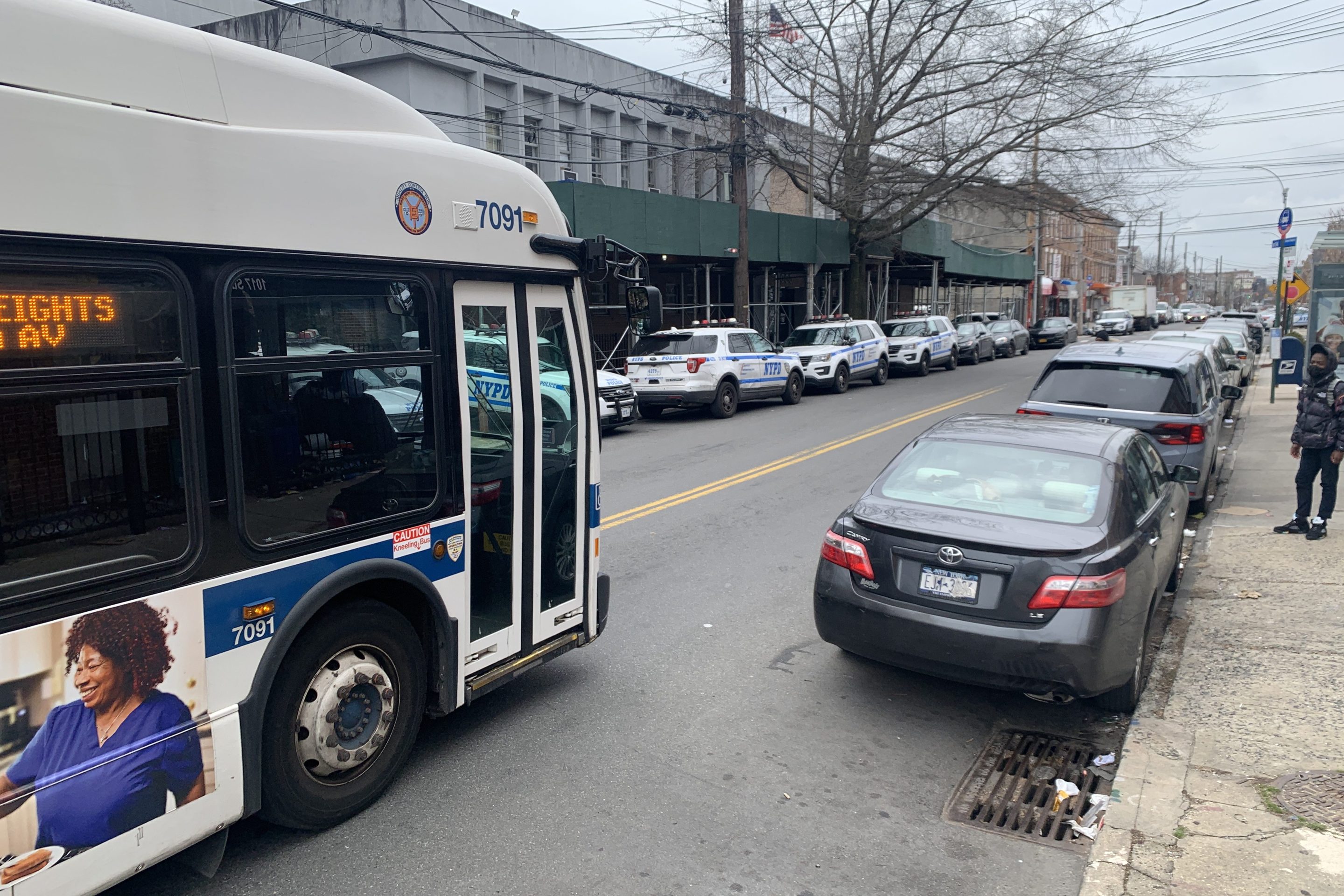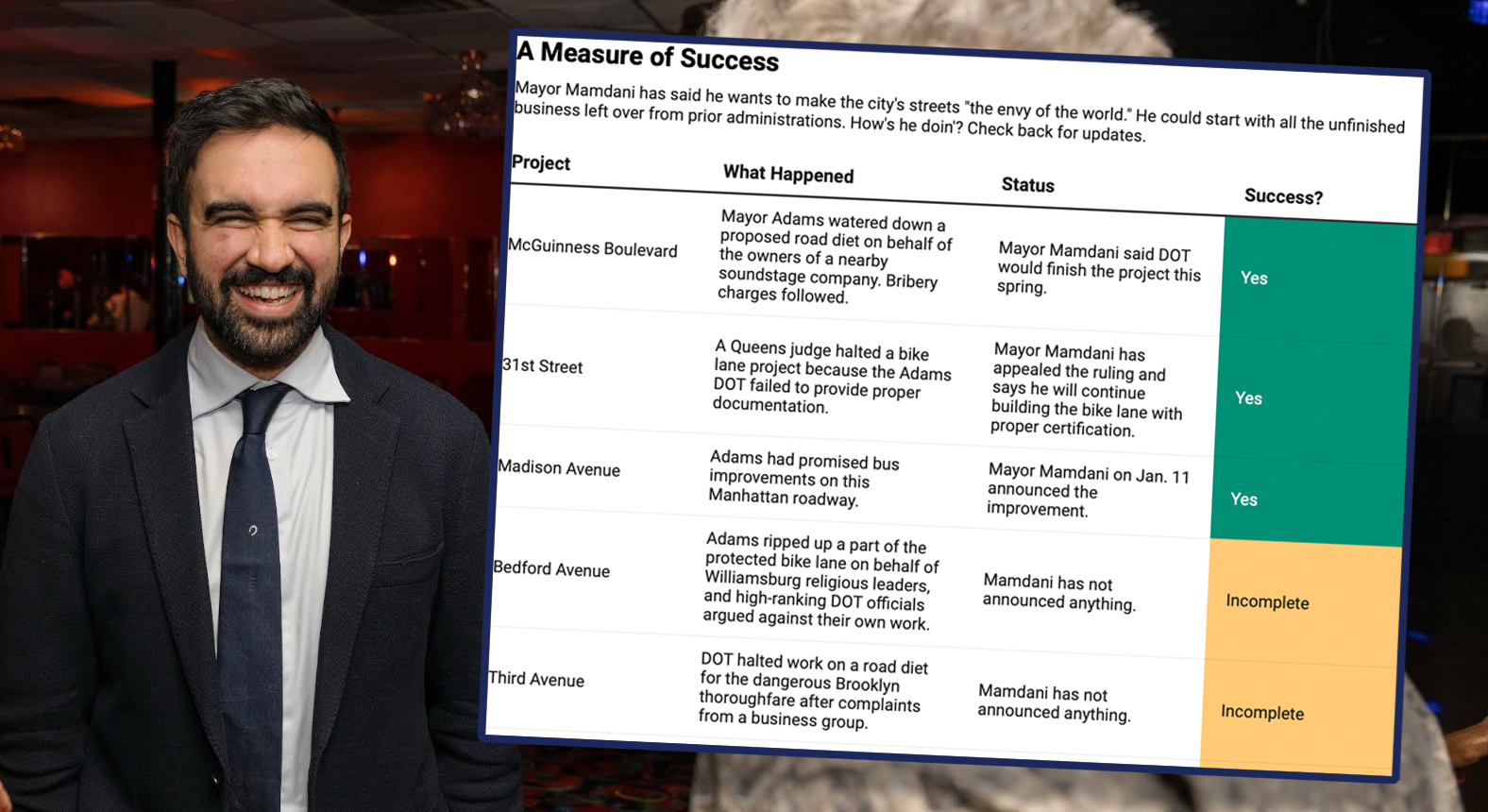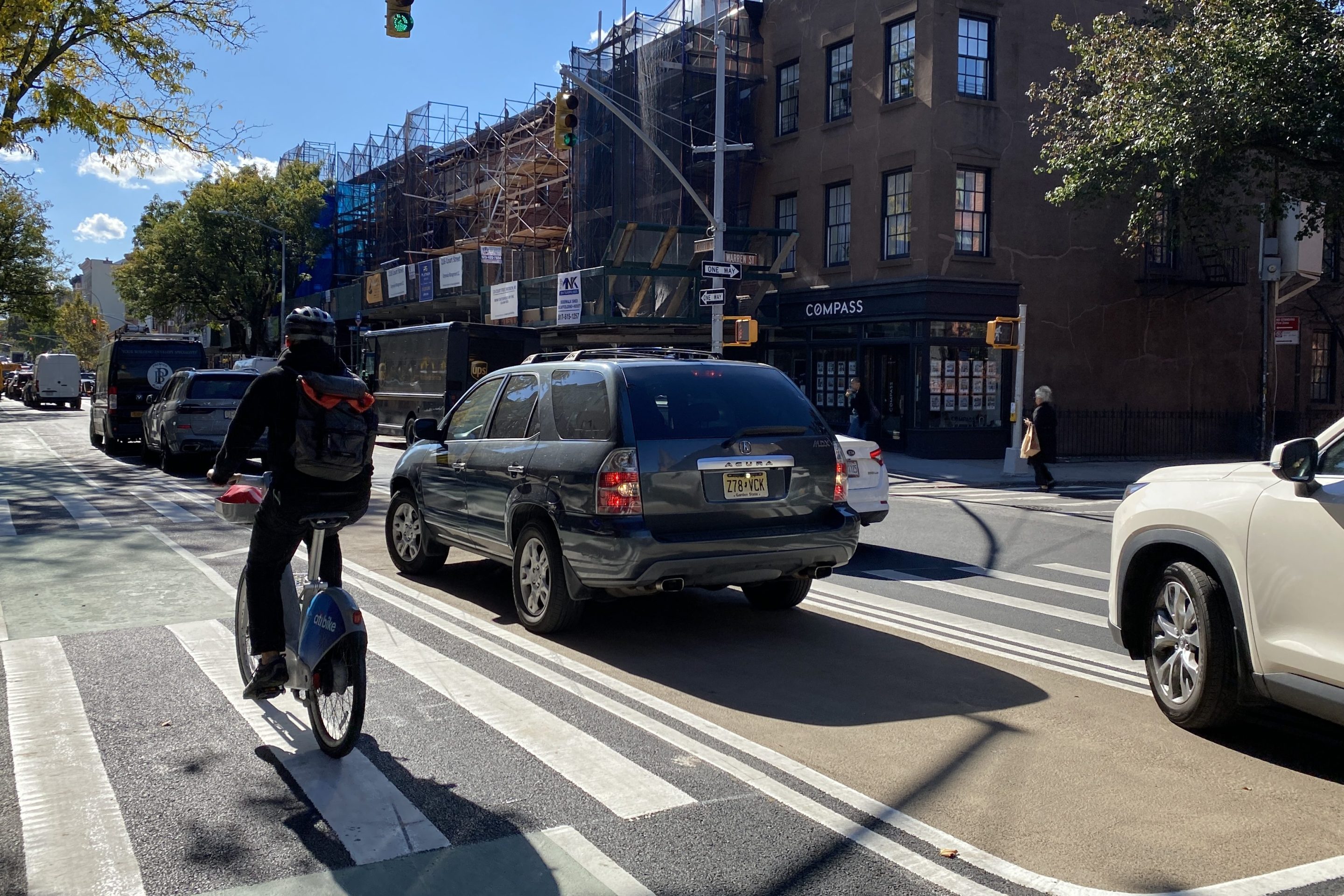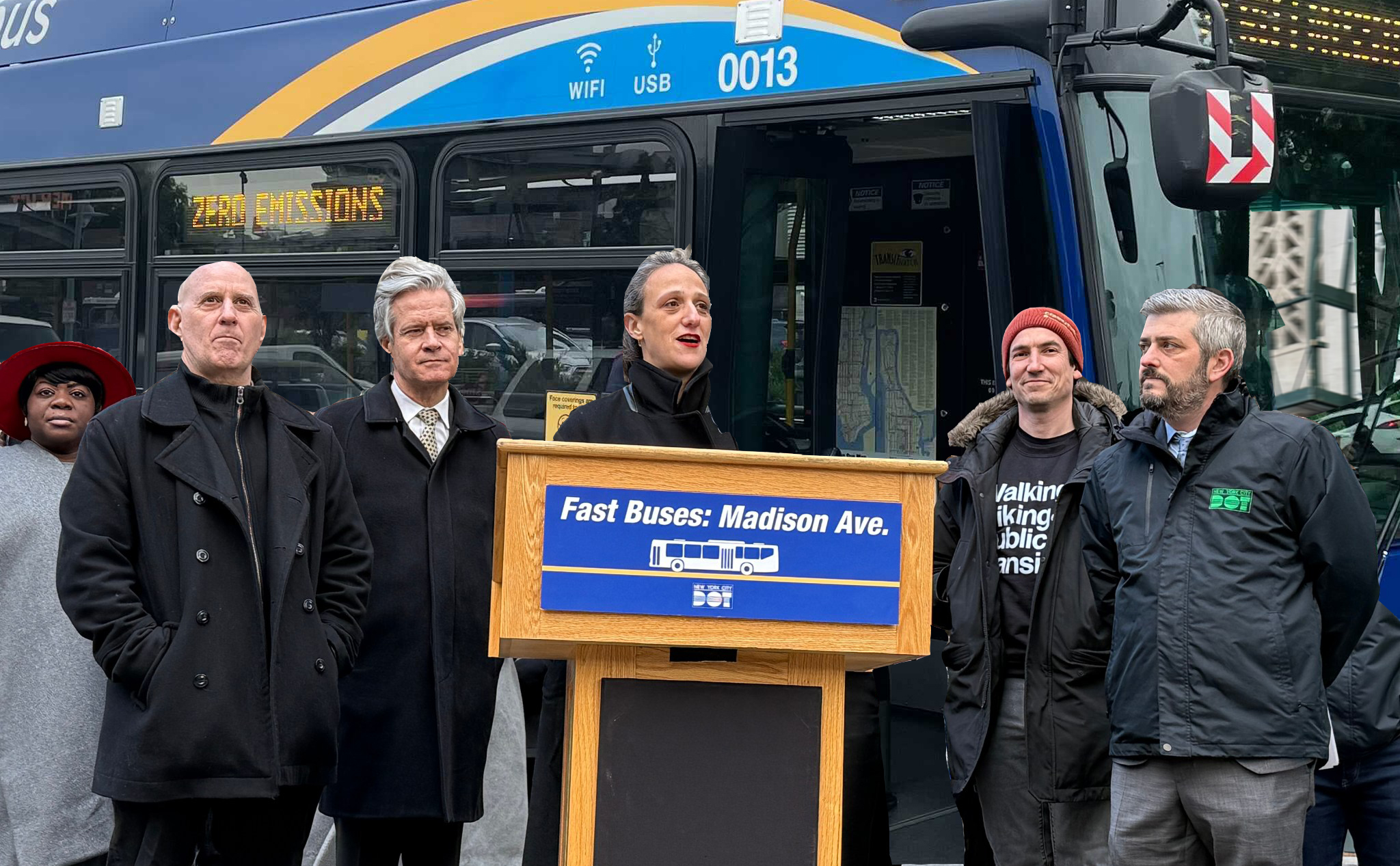The forced retirement of the NYPD’s Transportation Bureau Chief Kim Royster offers a fresh chance for safe street activists to push the beleaguered agency to do better at being a supposed Vision Zero partner of the Department of Transportation.
But what does the movement want from the police’s division tasked with enforcing safer streets, and should armed cops even be involved in that effort? That's a lot to unpack, so ...
First, what is the Transportation Bureau?
The NYPD's Transportation Bureau "is responsible for the safety and security of motorists, passengers, pedestrians, and cyclists on the streets and highways throughout New York City and manages traffic control," according to its website.
Such broad language can mean everything ... or nothing.
The current Transportation Bureau took shape in the 1990s, when the NYPD absorbed the traffic enforcement agents from the DOT in 1996 along with the formerly separate Transit Police who patrolled the subways the year before.
Officials carved out Transit as its own division by 1999, significantly reducing the Transportation Bureau's portfolio.
Transportation now monitors and manages vehicle flow, patrols highways, and has 3,300 uniformed traffic enforcement agents that ticket drivers for moving or parking violations and can tow their cars.
But the stated mission of the agency — and its power over city transportation — can't cover up its failure in preventing traffic violence, activists say.
Indeed, the agency is itself part of the problem when its officers drive recklessly, park illegally in bike and bus lanes and deface their plates to avoid detection — about which the Transportation has been virtually silent.
I recommend helmets, but that is not where @NYPDTransport should focus its street safety work. It should programmatically educate police officers on the traffic laws--particularly the laws affecting cyclists, and particularly the CIS detectives who investigate fatal crashes. https://t.co/b26LuVlPSR
— Steve Vaccaro Law (@BicyclesOnly) August 13, 2023
Some have called for removing the Finest from traffic enforcement entirely, saying traffic enforcement stops too often escalate into deadly police violence.
So given all that, what does the movement for livable streets want when NYPD Commissioner Edward Caban replaces Royster? It isn't just a new figurehead — it's a new mission:
Start with the existing Job 1
The NYPD Transportation Bureau is supposed to be the city's law enforcement apparatus focused on street safety, but these cops have failed at basic tasks, like going after reckless driving, keeping bike and bus lanes clear, and ticketing and towing illegally parked cars — often the Boys in Blue are among the worst offenders as a visit to their precinct station houses will confirm.
Summonses for moving violations for the first six months of 2023 are still down more than 30 percent compared to pre-pandemic numbers during the same time in 2019, and ticketing for dangerous offenses like failure to yield are down 39 percent, according to police statistics, despite Mayor Adams vowing after taking office to crack down on those types of infractions.
NYPD's Collision Investigation Squad investigated just about 5 percent of the 6,600 serious crashes in 2020, only one-third of which led to an arrest, and the cops stopped responding to minor car crashes. (Prior NYPD Commissioner James O'Neill famously turned down more funding for more CIS investigations.)
New bike lanes quickly become dangerous or unusable due to drivers parking in them, all while cyclist deaths are rising to historic levels this year.
Mayor Adams should set up a dedicated lane squad with parking agents, cops, and tow trucks to keep them clear, said Jon Orcutt of Bike New York.
“There’s enough known trouble spots that they will definitely be able to charge some overtime,” Orcutt said. “The city has been at cross purposes for years doing a lot of work on these lanes and then completely letting them fall into dysfunction the day after they’re implemented.”
Mayor Adams should make the Transportation Bureau a key player in his public safety agenda, Orcutt added. Advocates cited the tenure of former NYPD Transportation Chief Michael Scagnelli in the 2000s, who was instrumental in creating the reporting system TrafficStat and earned praise from advocates for taking dangerous behavior on the road seriously.
"It should be a prominent piece of the mayor’s messaging on public safety," Orcutt said. "If you’ve got cars on sidewalks, bike lanes, that puts people at risk."
Parking placard abuse remains rampant and there’s been a sharp rise in obstructed license plates, including among cops themselves, along with an exploding black market for fraudulent temporary tags that Streetsblog detailed in a three-part investigation earlier this year. Meanwhile, the police and the Department of Investigation repeatedly failed to follow a city law to report and crack down on placard abuse.
Cops don't just ignore the law, but they're sometimes ignorant of it, like when officers falsely used a law to confiscate bikes from kids for not having bells, all while O'Neill himself rode around without a ringer yet encountered no enforcement problems.
Citizen reporting of driver misconduct to 311 has led to officers closing out thousands of tickets without any action or active harassment of tipsters, which prompted a probe by the Department of Investigation. One social media watchdog said the city needs to get serious about the low-level corrupt behavior.
“New York City needs consistent and equitable ticketing. Orders need to be clear that placards are not exempt from enforcement, and it needs to be backed up with a combination of discipline for skipping placards and protection against retaliation for doing their job,” wrote the people behind the social media account @placardabuse, which only speaks anonymously because of prior harassment by the NYPD.
Transparency
The Transportation Bureau has a history of giving misleading, confusing, or downright false data to the public and lawmakers about its work.
Chief Royster told the Council last year that bike lane enforcement was up when it was down, while dodging questions about whether the NYPD was going after illegally parked tractor-trailers (those numbers also turned out to be down compared to previous years).
Her predecessor, Thomas Chan, was even worse and would give misinformation about hit-and-runs killing cyclists, blame increases in bikes for the soaring deaths of people riding them, and claim he would talk to precinct commanders about scofflaw cops parking illegally outside the station houses — which of course kept happening.
That inaction has consequences: as Streetsblog reported, there are more crashes on precinct blocks than on neighboring streets.
“They [NYPD] flatly lie about taking enforcement actions that they obviously never do and make up fake excuses for failing to do their job,” @placardabuse wrote.
The police should also release more stats that it keeps internally, like the number of bike thefts, said Elizabeth Adams, a senior advocacy and organizing director at Transportation Alternatives.
“It’s a huge issue, it happens all the time and we’re not being able to be proactive about it,” she said.
Rein in car chases
There has been a frightening surge in police car chases under Mayor Adams, with more pursuits in the first six months of this year than the previous five years combined, The City reported, despite the NYPD’s official policies and guidelines saying they should only be used as a last resort.
The high-speed cat-and-mouse games can wreak havoc on neighborhoods, such as the killing of 3-month-old Apolline Mong Guillemin in Fort Greene last year by a recidivist reckless driver who was being chased by cops.
“They are dangerous, they put pedestrians at risk, it’s why they’re prohibited and it needs to stop immediately, full stop,” said Adams of Transportation Alternatives. “That is something the transportation chief should step in, should play a role on.”
In the 1990s, the former Transit Police understood that “careless or reckless driving has no place in a professional police department,” according to this vintage clip, but the Adams administration has taken a different approach.
Another blast from the past with this video we created in the early 90s while I was privileged to lead the then-separate NYC Transit Police Department. It was one of many messages to help motivate the cops and inform New Yorkers as we encouraged them to support the police. Still… pic.twitter.com/YxBUDYnVIp
— Bill Bratton (@CommissBratton) August 4, 2023
“Our mayor has given us the mandate to start playing offense out here,” NYPD Chief of Patrol John Chell told CBS, citing mopeds as a vehicle of choice for criminals looking for quick escape.
Chief of Department Jeffrey Maddrey seemed to walk that effort back a bit when told the force last week to stop pursuing people when the risk to cops and the public is greater than letting a suspect go, the Post reported.
Fight illegal mopeds upstream
Mopeds have become an omnipresent mode of transportation in the city, and while their riders cause less death and destruction than car drivers, mopeds are now routinely encroaching on bike lanes not designed to accommodate these heavier and faster vehicles.
Part of the problem is the city’s failure to meet the boom of e-bikes with safe charging and storage infrastructure, prompting delivery workers to pivot to gas-powered mopeds.
The two-wheelers have become more popular because they're cheaper, but there's been a noticeable surge in such vehicles that are sold either illegally without a legally required vehicle identification number, or lacking license plates.
Cops have so far responded with limited ticketing of people coming off bridges plus some one-off seizures of mopeds, and Chell, who heads the separate Patrol Services Bureau, has basically taken over the beat from Royster by forming a nearly 200-strong unit known as the Community Response Team tasked with going after illegal vehicles.
The city must instead focus its efforts at the source: businesses selling the vehicles illegally or without requiring their customers to get license plates, according StreetsPAC Executive Director Eric McClure.
“A good number of them have the name of the place where they were sold,” said McClure. “So why are we not doing enforcement at the seller level?”
NYPD reps previously told Streetsblog it inspected more than 35 businesses and seized 154 non-street legal mopeds in 2022. But this year, cops visited 38 stores and found just one vendor selling non-street legal mopeds, the NYPD said.
The founder of the group Get Women Cycling said that police need to better understand the new modes of transportation better, rather than rely on stings.
“They’re just given the script that was probably in the training manuals for the last 30 years with regard to any other vehicle outside of an automobile,” said Angela Azzolino. “It’s already a very hostile environment for us on bikes, scooters and walking and so we do really need the collaboration from the police force to support us.”
Civilian enforcement
Should an armed police officer be the city’s main response to traffic infractions in the first place?
Policing researchers point to data showing that criminalization disproportionately targets people of color.
Last year, a whopping nine in 10 people arrested by the NYPD after traffic stops were Black or Latinx, and these interactions can easily escalate, said a director of the Center for Policing Equity, which tracks racial disparities in policing.
“You don’t need a person with a gun and a badge for all these incidents,” said Michelle Feldman. “Often we see these horrible incidents stemming out of low-level [infractions].”
California and North Carolina have been advancing legislation to permit local governments to civilianize their traffic enforcement, something that gained traction following the police killing of George Floyd in 2020.
It’s not a new idea.
For most of the 20th century, New Zealand had a separate federal civilian agency charged with enforcing traffic laws, whose officers “had a passion for road safety and an ideal of saving injuries and lives,” until the Kiwis merged them with police in the early 1990s during an era of government cost-cutting, according to Stanford University.
Advocates stressed the need to push for better street design that reduce injuries and fatalities without the need for police involvement, along with automated enforcement like speed and red light cameras.
"We need to see a shift away from police officer enforcement to self-enforcing streets, into pro-active measures that keep our cities safe," said Adams of Transportation Alternatives.
The NYPD declined repeated requests for comment about this story; Royster did not respond to an interview request.






